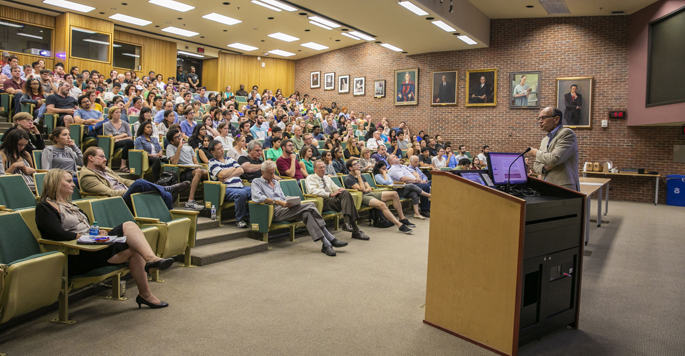
The human brain consists of perhaps as many as 1,000 trillion synapses, which transmit signals from one nerve cell to another with amazing speed, precision and plasticity.
Yet little is known about the molecular rules by which these fundamental computational units of brain signaling are formed and function.
“I would like to know those rules,” Nobel laureate Thomas Südhof, MD, said during last week’s Flexner Discovery Lecture sponsored by the Vanderbilt Brain Institute.
Südhof, the Avram Goldstein Professor in the Stanford University School of Medicine and a Howard Hughes Medical Institute investigator, studies how signaling molecules are transported in sac-like structures called vesicles, and how they are released at precise times to facilitate synaptic transmission.
In 2013, he shared the Nobel Prize in Physiology and Medicine for discoveries of the machinery that regulates vesicle traffic.
Addressing a packed crowd of more than 400 people who spilled into the aisles and out the doors of his Light Hall lecture room, Südhof described what he called the “molecular logic” of synapse formation.
Located on either side of the synapse, two classes of adhesion molecules — neurexins and latrophilins — organize and regulate synaptic properties, including neurotransmitter release, and mediate synapse formation and specificity.
These molecules have behavioral implications, too. Genetic mutations affecting the structure and function of neurexins, for example, have been associated with autism, schizophrenia and other neuropsychiatric disorders.
Yet synapse formation is not a developmental process. “Synapses are continuously restructured,” Südhof said. “They form throughout life.”
The brain’s extraordinary malleability gives hope to those who seek to understand and improve the treatment of brain disorders. In comparison to the trillions of ever-changing synapses, the human genome with its 20,000 to 25,000 genes, he said, “seems puny.”
For a complete schedule of Flexner Discovery Lectures and archived video of previous lectures, go to https://ww2.mc.vanderbilt.edu/dls/.












